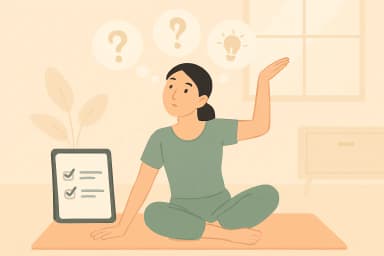
Reviewed by Arisa Tanaphon, Certified Pilates Trainer, Pilates & Mindful Movement Specialist
Ah, "Asian Pilates" — another phrase tossed into the wellness alphabet soup. But for many of us, it's a genuinely useful one. This approach blends classical Pilates principles with a calmer, breath-led flow, giving you a practical way to build core strength, ease joint stiffness, and lower everyday stress — especially if you prefer short, low-impact sessions at home.
As always, though, it isn't one-size-fits-all. Bodies, schedules, and starting points differ. When you're getting into movement, it's easy to compare your progress to someone else's highlight reel and feel behind. Don't. What matters is stacking small, repeatable wins and learning to move well at your pace.
So here's the lowdown on Asian Pilates — what it is (and isn't), who it can help, the benefits you can realistically expect, and a simple way to start without fancy equipment.
Key takeaways
- Asian Pilates is a contemporary Pilates approach that blends classical Pilates principles (breath, control, alignment, precision) with mindful, flowing pacing inspired by common Asian movement philosophies (smooth sequencing, breath-led focus, soft joints).
- It's beginner-friendly: mostly mat-based, minimal equipment, and scalable intensity using bodyweight, bands, or light props.
- Expected benefits: core strength, mobility, posture, balance, and stress regulation. Think "calm strength," not max burn.
- It's suitable for desk workers, beginners, and returning exercisers. Special formats can be adapted for prenatal/postnatal with professional guidance.
What is Asian Pilates?
Asian Pilates is a style of Pilates that emphasizes gentle flow, breath pacing, and body awareness while retaining the evidence-informed pillars of Pilates: neutral alignment, core control, mobility through full ranges, and precise, low-impact movement. Classes are typically slower and more meditative than "power" formats, with an intentional arc: arrive → mobilize → build → restore.
You'll see familiar Pilates patterns (spinal articulation, hip hinging, anti-rotation core work), but with softer transitions, longer exhales, and mindful cues to down-shift stress and improve movement quality.
Take a quiz
Answer a few quick questions to see if Asian Pilates fits your goals.
Is Asian Pilates for me?

How it differs from classical Pilates
- Pace: slightly slower, breath-first cueing.
- Sequencing: smoother flow between moves, fewer abrupt resets.
- Focus: joint "softness," fascia-friendly mobilization, nervous-system calm.
- Equipment: mostly mat & minimal props (bands, pillow, light ball) vs. heavy apparatus.
Benefits (and limits)
Physical
- Core & postural strength: deep abdominals, hip stabilizers, and mid-back endurance.
- Mobility & joint comfort: gentle ranges reduce stiffness from sitting.
- Balance & coordination: controlled tempo builds stability safely.
- Low-impact conditioning: useful on rest days or after time off.
Mental
- Stress regulation: breath pacing + steady tempo can lower perceived tension.
- Body awareness: better movement quality = fewer "flare-ups" from rushed form.
What Asian Pilates can and can't do
Can:
- Improve posture, mobility, and core endurance
- Support back comfort with technique and gradual loading
- Complement cardio/strength days and active recovery
Can't:
- Guarantee weight loss or spot reduction
- Replace clinical rehab for injury without professional oversight
- Override poor sleep, nutrition, or high stress
Who is it for?
- Beginners & desk workers: want low-impact, structured movement.
- Returning exercisers: rebuilding consistency and confidence.
- Athletes on recovery days: mobility + control without fatigue overload.
- Prenatal/Postnatal: only with tailored modifications and clinician clearance.
How to start (equipment, space, and pacing)
- Space: yoga mat length; floor free on both sides.
- Clothing: non-slip socks or barefoot; comfortable, non-restrictive wear.
- Props (optional): mini-band, light pilates ball/pillow, yoga block.
- Pacing rule: use RPE 4–6/10 (moderate). If you can't breathe smoothly, scale down.
- Progression: +1 session/week or +3–5 minutes/class—not both at once.
FAQ
It helps consistency and recovery, which supports weight goals, but fat loss primarily follows nutrition, sleep, and total activity.
2–4 sessions/week for beginners. Add a short mobility day on top if you sit a lot.
Mobility/posture awareness often improves in 2–4 weeks; strength/endurance in 6–8+ weeks with steady practice and recovery.
No. They share breath and mindfulness, but Pilates prioritizes spinal mechanics, core control, and precision under light load.
Mat is accessible and foundational. Reformer adds resistance and feedback. Many start with mat, then sample Reformer later.
Often, yes—with clearance and careful scaling (neutral spine, short ranges, breath-led tempo). Persistent pain → see a clinician.
Updated: November 8, 2025




